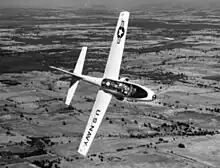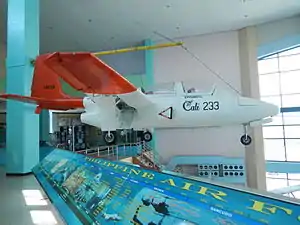Temco TT Pinto
The Temco TT Pinto is a tandem two-seat primary jet trainer built for the United States Navy by Temco Aircraft of Dallas, Texas.
| TT Pinto | |
|---|---|
_c1957.jpeg.webp) | |
| Temco TT-1 in testing | |
| Role | Jet Trainer |
| Manufacturer | Temco Aircraft |
| First flight | 26 March 1956 |
| Introduction | 1959 |
| Retired | 1960 |
| Primary user | United States Navy |
| Number built | 15 |
| Variants | AJI T-610 Super Pinto |
Design and development

The Temco Model 51 had been initially proposed to the US Air Force in response to an Air Force competition for a jet-powered primary trainer, which was won by the Cessna T-37 Tweet. The concept behind the Model 51 was an attempt to provide primary training in a jet-powered aircraft. The official name for the Model 51 was the Pinto.
The Pinto was a mid-wing, tricycle landing gear trainer with an enclosed cockpit powered by a single Continental Motors J69-T-9 (license-built Turbomeca Marboré) jet engine. The aircraft carried no armament.
The TT-1s were equipped with many of the same features found in operational jets, including ejection seats, liquid oxygen equipment, speed brakes, along with typical flight controls and instrument panels. Although the flight characteristics were considered good, the "wave off" capability was rated marginal due to being slightly underpowered.
After its first flight in 1956, the prototype was sent to the Naval Air Test Center (NATC) Patuxent River to be evaluated alongside the Beech Model 73 Jet Mentor. Fourteen of the aircraft, designated TT-1, were produced between 1955 and 1957.
AJI T-610 Super Pinto
In 1968, American Jet Industries (AJI) (later to become Gulfstream Aerospace) re-engined a TT-1 Pinto. The J69 was replaced with a 2,850 lbf (12.7 kN) General Electric CJ610 (the civil version of the J85). The modified aircraft, called the T-610 Super Pinto, flew on 28 June 1968.[1] The new engine significantly increased performance, with maximum speed reaching 450 kn (518 mph; 833 km/h), and AJI marketed the aircraft as a light attack aircraft.[1][2]
The prototype Super Pinto, together with drawings and production rights, were purchased by the Philippine Air Force, which planned to build the aircraft as the T-610 Cali.[3]
Operational history

In 1959, these aircraft served in the Air Training Command at Pensacola, Florida and used in a training program demonstration testing the feasibility of using a jet-powered trainer for primary flight training.
By the end of 1960, the TT-1s were phased out of operations in the Naval Air Training Command because performance was deemed insufficient,[4] and sold as surplus.
Variants
- TT-1 Pinto
- Two-seat primary jet trainer aircraft.
- American Jet Industries T-610 Super Pinto
- Re-engined with 2,850 lbf (12.7 kN) General Electric CJ610-6 turbojet.[1]
Surviving aircraft

In December 2016, five of the TT-1 Pinto series still appeared on the U.S. civil roster[5] (one with an expired certificate[6]), down from seven, four of them Super Pintos, in 2011.[7]
As of late 2015, one T-610 prototype was still preserved at the Philippine Air Force Museum.[8]
Specifications (TT-1)
Data from Jane's All The World's Aircraft 1956–57[9]
General characteristics
- Crew: 2
- Length: 30 ft 7 in (9.32 m)
- Wingspan: 29 ft 10 in (9.09 m)
- Height: 10 ft 10 in (3.30 m)
- Wing area: 150 sq ft (14 m2)
- Gross weight: 4,440 lb (2,014 kg)
- Fuel capacity: 119 US gal (99 imp gal; 450 L) normal; 165 US gal (137 imp gal; 620 L) max
- Powerplant: 1 × Continental YJ69-T-9 centrifugal flow compressor turbojet engine, 920 lbf (4.1 kN) thrust
Performance
- Maximum speed: 345 mph (555 km/h, 300 kn) at 15,000 ft (4,600 m); 328 mph (285 kn; 528 km/h) at sea level
- Cruise speed: 247 mph (398 km/h, 215 kn) at 25,000 ft (7,600 m)
- Stall speed: 76 mph (122 km/h, 66 kn) at take-off weight: 69 mph (60 kn; 111 km/h) at landing weight
- Never exceed speed: 518 mph (834 km/h, 450 kn)
- Endurance: 1.5 hours
- Service ceiling: 30,000 ft (9,100 m)
- Rate of climb: 1,900 ft/min (9.7 m/s)
See also
Related development
Aircraft of comparable role, configuration, and era
References
- Taylor 1971, p. 223.
- Field Flight International 16 October 1976, p. 1185.
- Flight International 1 March 1980, p. 680.
- "TT-1 Pinto | National Naval Aviation Museum". www.navalaviationmuseum.org. Archived from the original on 2014-07-13.
- FAA Registry for Temco TT-1 Pinto, retrieved 07 Dec 2016.
- FAA Registry for N4486L, retrieved 07 Dec 2016.
- Murphy, Kevin (2011). "TT-1 Pinto". Warbird Alley. "One of the seven is a Super Pinto kept flying by the World Heritage Air Museum at Detroit City Airport." Retrieved on 2009-11-08 from http://www.warbirdalley.com/pinto.htm.
- 44233 at Manila - Ninoy Aquino International by Paul Chandler1 on netAirspace.com, retrieved 07 Dec 2016.
- Bridgman, Leonard, ed. (1956). Jane's all the World's Aircraft 1956–57. London: Jane's all the World's Aircraft Publishing Co. Ltd. p. 342.
Bibliography
- Dillon, Mike. "Will lovely loser become super winner?" Air Progress, Vol. 24, no. 3, March 1969.
- Field, Hugh (16 October 1976). "Launch Pad for Hustler". Flight International. pp. 1184–1185. Archived from the original on 24 December 2013.
- Frankel, Mark. Temco TT-1 Pinto (Naval Fighters Nº72). Simi Valley, California: Ginter Books, 2007. ISBN 0-942612-72-8.
- "Military Aircraft of the World". Flight International. 1 March 1980. pp. 641–694. Archived from the original on 24 December 2013. Retrieved 23 December 2013.
- Taylor, John W. R. Jane's All The World's Aircraft 1971–72. London: Sampson Low, Marston & Co. Ltd, 1971. ISBN 0-354-00094-2.
- Taylor, Michael J.H. Jane's Encyclopedia of Aviation (Vol. 5). Danbury, Connecticut: Grolier Educational Corporation, 1980. ISBN 0-7106-0710-5.
External links
- Temco Model 51
- Temco TT-1 "Pinto"
- Minijets – Temco 51 TT-1 Pinto Archived 2011-08-09 at the Wayback Machine